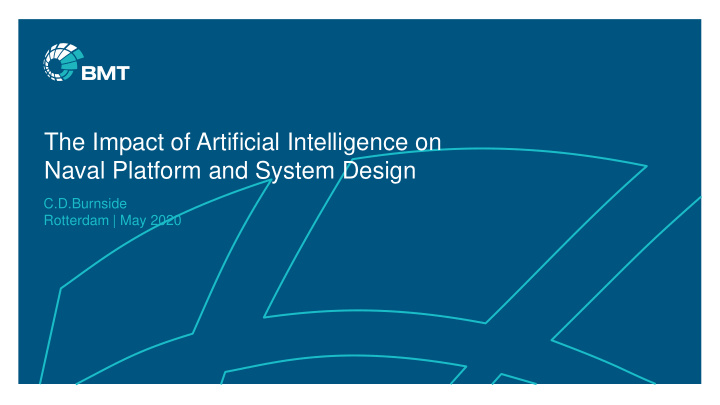



The Impact of Artificial Intelligence on Naval Platform and System Design C.D.Burnside Rotterdam | May 2020
Premise of Research Assess onboard and offboard naval combatant platform functions and identify those which can be enhanced significantly by the implementation of intelligent techniques Identify the intelligent techniques proposed to facilitate the perceived step-changes in capability and value proposition Identify the risks associated with the adoption of intelligence within the functions proposed
Three Generations of Artificial Intelligence Artificial Narrow Intelligence (ANI) – machine intelligence that equals or exceeds human intelligence for specific tasks; Artificial General Intelligence (AGI) – machine intelligence meeting the full range and capability of human performance across any task; Artificial Super Intelligence (ASI) – machine intelligence that exceeds human intelligence across any task.
Applicable AI Approaches & Techniques Natural Anomaly Reinforced Predictive Language Learning Analytics Detection Processing Neural Prescriptive Robotics Fuzzy Logic Analytics Networks Bayesian Machine Convolutional Neural Automation Neural Perception Network Network Layered Long Short- Modular Ant Colony Semantics Term Optimisation Neural Analysis Memory Network
Concurrent, Complimentary Technology Propulsion Navigation Battery Technology Simultaneous Localisation and Mapping Supercapacitors/Ultracapacitors Quantum Positioning Energy Harvesting Automated Celestial Navigation Firefighting Communication Security Hypoxic Air 5G Adaptive, Fluid Security Inergen Systems SATCOM Developments Architectures Distributed Sensors Optical Communications Quantum Key Distribution
Functional Breakdown > 140 functions assessed Categorised within 6 functional domains – Warfare Navigation Platform Management Recoverability Logistics Maintenance
Warfare Behaviour Command & Target Target Electronic Analysis of Prediction of Hard Kill Control Classification Prosecution Warfare SIGINT Hostile Systems Close Proximity Above Water Below Water Signature Target Sensor Data Force Target Tracking Soft Kill Soft Kill Management Acquisition Analysis Protection Intelligent systems to deliver: Perform sharper anomaly detection Relieve personnel of the cognitive stresses and strains of making high profile, high impact decisions Eliminate human-induced error and uncertainty Team with the human to compliment their skills and capabilities and improve overall output Counter threats from weapons which compress the decision making time beyond the threshold of a human
Navigation Complex Navigation Defensive Manoeuvres Planning Manoeuvres Control Dynamic Navigation Tactical Platform Execution Manoeuvres Motions Intelligent systems to deliver: Conduct fully autonomous navigation Perform evasive, defensive and tactical manouevres Conduct navigation planning activities Support decision to and definition of re-routing and course correction Team with the human to support the undertaking of the above Collaborate and share data with other platforms to assist in optimising of route plans
Platform Management Power Conduct Lifting Fuelling of Safe Recovery Generation and Handling Boats and UxVs of Sea Assets Management Operations Optimise Power Safe Recovery Fuelling of Equipment Distribution of Air Assets Aircraft Operation Optimisation Intelligent systems to deliver: Recommend optimum efficiencies for power and propulsion Exploit mission data to predict requirements for optimum efficiency Automate machinery control to reduce operator workload Automation via robotics for deck operations to reduce personnel numbers
Recoverability Damage Modelling and Control Damage Display of Command & Containment Platform Control Damage Fixed Reconfigure Damage Firefighting Damaged Detection Systems Systems Intelligent systems to deliver: Collect information and conduct damage assessment to present operators with a clear damage control picture Recovery prioritization and recommendations to reduce operator workloads Automate recovery functions to reduce personnel and minimise exposure to hazards
Logistics Consumables Conduct Watch Management Underway Stores Replenishment Management Intelligent systems to deliver: Monitor, track and predict onboard consumables, stores and spares Monitor, track and predict consumables within integrated logistics supply chain Automate some stores or munitions retrieval applications Automate fueling for unmanned platforms
Maintenance Monitor Reactive Systems for Maintenance Failure Planning Indicators Routine Maintenance Planning Intelligent systems to deliver: Timely prediction of equipment failure and maintenance Automate systems operation to optimise availability and account for failure Undertake maintenance via robotics Enact reversionary or fall-back modes in cases of degradation or failure
Key Risk Themes Data quality – particularly in respect to Protracted test & assurance regimes with current systems’ ability to record data to difficulty in defining an ‘end’ ‘educate’ learning systems Risk, cost and user appetite to include new Using intelligent systems in high complexity, technologies in acquisition programmes Potential magnitude of SWaP margins and high interdependency systems Assuring and understanding system high system complexity Heightened levels of vulnerability and transparency and certainty The ability of intelligent systems to consider susceptibility Networking philosophy demanding complex all permutations Achieving accreditation and certification, and convoluted architectures ‘Ripple Effect’ throughout the enterprise especially where the system is making safety-critical decisions in terms of accountability and safety integrity
Key Opportunity Themes Shortening of decision times and hence Effective countering of large swarm threats Reducing or eliminating hazardous and/or delay Reducing or eliminating error and uncertainty manual activities Relieving personnel of cognitive stress and Functional performance optimisation Cross-platform collaboration strain Appropriate teaming arrangements to Potential for competitive advantage in hotly optimise output contested fields Reductions in personnel numbers Extension of platform operating envelope
Platform Design System architectures for automated recoverability and System architectures enhanced redundancy optimised for maximum availability including Topside transmitter and enhanced redundancy receiver conflicts Increase in weight and installation effort for network infrastructures Greater margin demand to automate launch and recovery of boats and UXVs Additional space and Platform and system weight and for arrangement automated magazine philosophies handling and deck Enhanced fire and systems flood containment arrangements
Evolutionary versus Revolutionary Transformation
Looking ahead… To be completed
Thank you
Recommend
More recommend